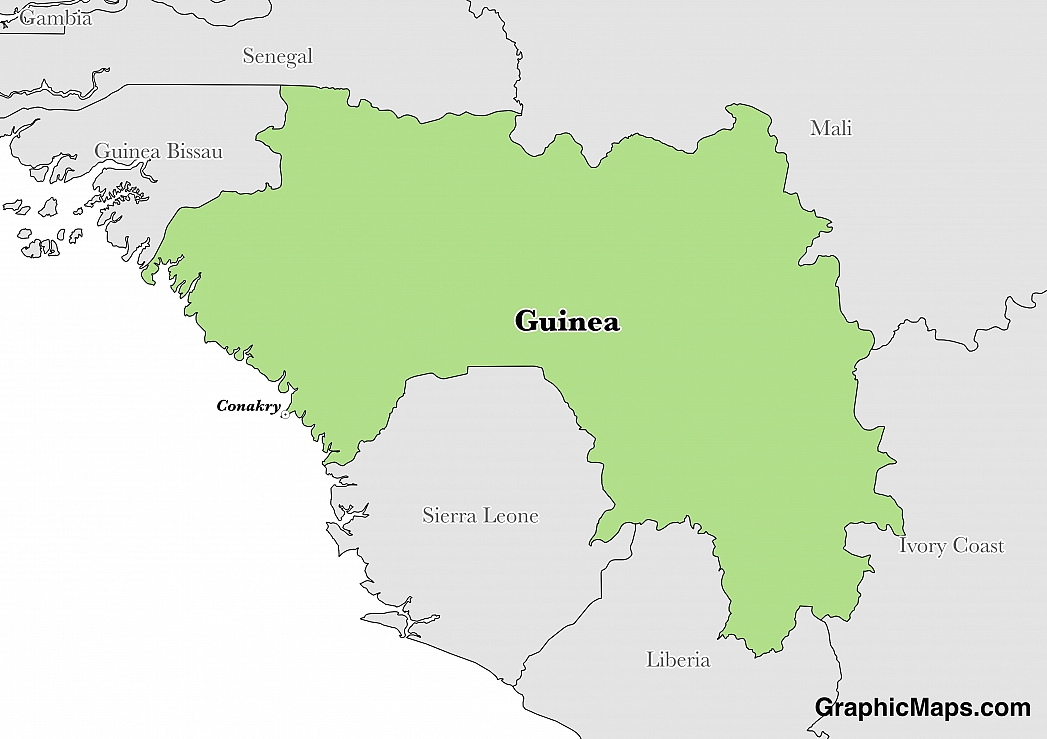Where is Guinea?
Located in Western Africa, Guinea has a 4,046.00 km border with Cote d'Ivoire (816 km), Guinea-Bissau (421 km), Liberia (590 km), Mali (1,062 km), Senegal (363 km) and Sierra Leone (794 km). It has a 320.00 km coastline. Sierra Leone has protested Guinea's continued occupations of some lands near the Makona and Moa Rivers.
Guinea’s capital city is Conakry. It became a capital in 1904 and has grown significantly since then. Statistics in 2014 indicate that its population was 1,660,973. Interesting places to visit in Conakry include Conakry Botanical Garden, Presidential Palace, Sandervalia National Museum, and Fouta Djallon. The city’s climate is the tropical monsoon often influenced by the Harmattan winds.
Read more on Guinea's CapitalGuinea is an African country covering 245,857.00 km2 of which 0.06% is water and 245,717.00 km2 is land. This makes it the 77th largest country in the world and slightly smaller than Oregon. Its geographic coordinates are 11 00 N, 10 00 W and Conakry is the capital city.
The name of the country comes from the Guinea region of West Africa.
Its ISO code is GN.
Geography
Guinea has a mean elevation of 472 m above sea level.
It has a hot and humid cliimate with monsoons in the rainy season of June to November and mild weather in the dry season from December to May. Its terrain is mostly flat, with a hilly to mountainous interior.
Population
Guinea has a population of 12,093,349 making it the 75th largest in the world.
French is the official language. The major ethnic groups reported include Fulani, Malinke, and Susu. The majority of the country is Muslim.
French is the official language used in Guinea. The language has 26 letters forming its Latin alphabet. It is also popular for its Romantic orientation. The most widely spoken vernacular language in Guinea is Fula. Minority languages spoken in Guinea include Zialo, Kissi, and Kpelle.
Read more on Guinea's LanguagesThe dialing code for the country is 224.
Government
Guinea is an independent country. It gained independence from France in 1958. Its constitution was last ratified in 1990.
Guinea is an independent state governed by a president. The president is in charge of running the state and the government. In executing his duties to the government, he appoints a Prime Minister and a Cabinet. In addition to the executive, Guinea’s governance also includes contributions from the judiciary and parliament. Ideally, elections in Guinea should take place after every five years.
Read more on Guinea's GovernmentEconomy
Factoring in Purchasing Power Parity, Guinea's GDP is $16,080,000,000.00 (USD) with $1,300.00 (USD) per capita. This makes it the 152nd largest economy and its citizens the 211th richest in the world. The currency of Guinea is the Franc (GNF).
Its major export partners are India, Spain, and Ireland. Its main exports are bauxite, gold, and diamonds. Its major import partners are China, the Netherlands, and India. Its major imports include petroleum products, metals, and machinery.
Flag
The flag of Guinea resembles the French tricolor due to its arrangement of vertical bands. However, its colors differ from the French flag as they are yellow, green, and red. The red on the flag symbolizes the blood that was shed as the country fought for its independence. The green color shows the green vegetation on the land and the yellow color is the sun. The three colors are similar to those used by the Pan-African movement. The flag of Guinea was adopted in 1958.
Read more on Guinea's FlagThis page was last modified on January 17th, 2018
More on Graphicmaps

Published on 2019-11-06
What is a Trade Embargo?

Published on 2019-11-04
Which Two Countries Used to Have the Same Flag?

Published on 2019-09-16
What Is the Only Two-Sided State Flag?

Published on 2019-09-16
Which Country Flag Looks Like the Texas Flag?

Published on 2019-08-29
Flags That Resemble the US Flag

Published on 2019-08-20
